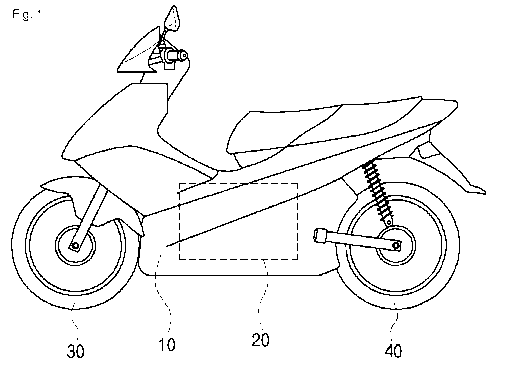Some of the information on this Web page has been provided by external sources. The Government of Canada is not responsible for the accuracy, reliability or currency of the information supplied by external sources. Users wishing to rely upon this information should consult directly with the source of the information. Content provided by external sources is not subject to official languages, privacy and accessibility requirements.
Any discrepancies in the text and image of the Claims and Abstract are due to differing posting times. Text of the Claims and Abstract are posted:
| (12) Patent Application: | (11) CA 2702059 |
|---|---|
| (54) English Title: | MOTORCYCLE |
| (54) French Title: | MOTO |
| Status: | Deemed Abandoned and Beyond the Period of Reinstatement - Pending Response to Notice of Disregarded Communication |
| (51) International Patent Classification (IPC): |
|
|---|---|
| (72) Inventors : |
|
| (73) Owners : |
|
| (71) Applicants : |
|
| (74) Agent: | |
| (74) Associate agent: | |
| (45) Issued: | |
| (86) PCT Filing Date: | 2008-10-10 |
| (87) Open to Public Inspection: | 2009-04-16 |
| Examination requested: | 2010-06-23 |
| Availability of licence: | N/A |
| Dedicated to the Public: | N/A |
| (25) Language of filing: | English |
| Patent Cooperation Treaty (PCT): | Yes |
|---|---|
| (86) PCT Filing Number: | PCT/KR2008/005959 |
| (87) International Publication Number: | KR2008005959 |
| (85) National Entry: | 2010-04-08 |
| (30) Application Priority Data: | ||||||
|---|---|---|---|---|---|---|
|
A motorcycle has at least two independently driven wheels to reduce energy
consumption. The independently driven
wheels are driven independently.
L'invention concerne une moto présentant au moins deux roues qui sont indépendamment entraînées pour réduire la consommation d'énergie de la moto. Les roues indépendamment entraînées sont entraînées de manière indépendante.
Note: Claims are shown in the official language in which they were submitted.
Note: Descriptions are shown in the official language in which they were submitted.

2024-08-01:As part of the Next Generation Patents (NGP) transition, the Canadian Patents Database (CPD) now contains a more detailed Event History, which replicates the Event Log of our new back-office solution.
Please note that "Inactive:" events refers to events no longer in use in our new back-office solution.
For a clearer understanding of the status of the application/patent presented on this page, the site Disclaimer , as well as the definitions for Patent , Event History , Maintenance Fee and Payment History should be consulted.
| Description | Date |
|---|---|
| Inactive: IPC assigned | 2019-08-13 |
| Inactive: First IPC assigned | 2019-08-13 |
| Inactive: IPC removed | 2019-08-13 |
| Inactive: IPC removed | 2019-08-13 |
| Inactive: IPC assigned | 2019-08-13 |
| Application Not Reinstated by Deadline | 2013-09-12 |
| Inactive: Dead - No reply to s.30(2) Rules requisition | 2013-09-12 |
| Inactive: IPC expired | 2013-01-01 |
| Inactive: IPC removed | 2012-12-31 |
| Inactive: Abandoned - No reply to s.30(2) Rules requisition | 2012-09-12 |
| Inactive: S.30(2) Rules - Examiner requisition | 2012-03-12 |
| Letter Sent | 2010-07-19 |
| Request for Examination Requirements Determined Compliant | 2010-06-23 |
| Request for Examination Received | 2010-06-23 |
| All Requirements for Examination Determined Compliant | 2010-06-23 |
| Inactive: Cover page published | 2010-06-07 |
| Inactive: Notice - National entry - No RFE | 2010-06-04 |
| Inactive: IPC assigned | 2010-06-01 |
| Inactive: IPC assigned | 2010-06-01 |
| Inactive: IPC assigned | 2010-06-01 |
| Application Received - PCT | 2010-06-01 |
| Inactive: First IPC assigned | 2010-06-01 |
| Inactive: Inventor deleted | 2010-06-01 |
| National Entry Requirements Determined Compliant | 2010-04-08 |
| Application Published (Open to Public Inspection) | 2009-04-16 |
There is no abandonment history.
The last payment was received on 2012-10-09
Note : If the full payment has not been received on or before the date indicated, a further fee may be required which may be one of the following
Patent fees are adjusted on the 1st of January every year. The amounts above are the current amounts if received by December 31 of the current year.
Please refer to the CIPO
Patent Fees
web page to see all current fee amounts.
| Fee Type | Anniversary Year | Due Date | Paid Date |
|---|---|---|---|
| Basic national fee - standard | 2010-04-08 | ||
| Request for examination - standard | 2010-06-23 | ||
| MF (application, 2nd anniv.) - standard | 02 | 2010-10-12 | 2010-10-06 |
| MF (application, 3rd anniv.) - standard | 03 | 2011-10-11 | 2011-10-06 |
| MF (application, 4th anniv.) - standard | 04 | 2012-10-10 | 2012-10-09 |
Note: Records showing the ownership history in alphabetical order.
| Current Owners on Record |
|---|
| HYUN SIK JANG |
| YONG BURN KWON |
| Past Owners on Record |
|---|
| None |